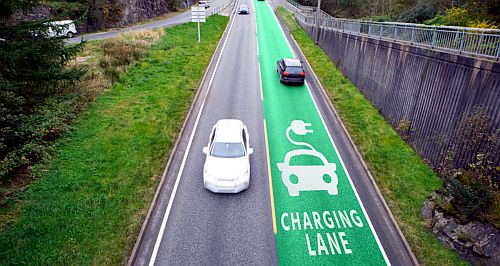Make / Model Search
News - General NewsSwinburne Uni to trail on-road EV charging techUni receives $3m grant to trial DWPT on Aussie roads, but does the model make sense?21 Feb 2024 By MATT BROGAN SWINBURNE UNIVERSITY is set to receive a $3 million grant from the Australian government it says will accelerate the implementation of embedded dynamic charging technology – also known as Dynamic Wireless Power Transfer (DWPT) – for electric vehicles travelling on our roads.
The trial aims to create what Swinburne University says is a safer, greener, and more efficient transport sector, estimating that the technology could save the Australian economy as much as $324 billion dollars by the middle of the century.
In electrifying heavy vehicles – and ensuring they are charged wirelessly while driving, it is anticipated trucks and buses will receive sufficient energy to travel long distances without the need for time-consuming recharging breaks.
Swinburne University new energy technology research group leader Professor Mehdi Seyedmahmoudian says the trial has the potential to transform the heavy vehicle industry, removing many of the roadblocks that currently limit the uptake of electric heavy vehicles.
“This collaborative effort is a perfect example of our shared vision for a sustainable transport ecosystem that can significantly reduce our environmental footprint,” he said.
The $8.2 million prototype for embedding the technology on regional roads was funded in part by the Australian government’s Cooperative Research Centres Projects Grants scheme which aims to support short-term collaborative research projects.
Swinburne University’s embedded dynamic charging technology trial is a collaborative effort between several parties, including ACE Infrastructure, ARRB Group, Fleet Plant Hire, Net Zero Stack, the Royal Melbourne Institute of Technology (RMIT), and SEA Electric.
Professor Seyedmahmoudian says the project is the outcome of several years of study conducted between world-leading researchers and PhD students within the university’s New Energy Technologies Research Group.
The group worked alongside Chief Investigators Saad Mekhilef, a Distinguished Professor in Electrical Renewable Energy, and Alex Stojcevski, a Professor in Computing and Engineering Technologies and the Dean of School Science.
“We are thrilled to be providing a platform for researchers to collaborate with leading industry partners and contribute to real-world solutions in the development of sustainable and innovative energy solutions for the future of transportation,” said Professor Stojcevski.
GoAuto has reached out to Professor Seyedmahmoudian for further comment.
The flipside…
While it may seem that the road ahead is paved with good intentions, questions remain about the viability of DWPT technology, not least from a cost perspective.
Electric coils embedded in the road require significant amounts of copper and other materials to enable electron transmission to vehicles above.
A tremendous amount of power is required to supply electricity through the road – estimated at 1MW per kilometre/per lane – with transmission losses between the coils and the vehicle passing above of 10 per cent in the case of a compact two-seat vehicle.
A higher riding, heavier vehicle will see even greater losses given the distance between the chassis and the road surface…
Additionally, and based on current best-case scenarios (i.e., the Tesla Semi), an average 18-wheel semi-trailer consumes 1.7kWh of electricity per kilometre at cruise.
Multiply that by the estimated 3800 vehicles that use the Hume Freeway between Melbourne and Sydney each day, for example – and assuming each could utilise the technology – and it is calculated that some 5.6GWh of electricity would be required to supply that one stretch of road in any given 24-hour period.
Australia currently produces 272.0TWh of electricity per day and has a road network of 873,573km…
Additionally, previous studies carried out in India and China suggest the capability for a DWPT road requires “critical design of the entire system”, including not only the powered coils, but also electronic converters and compensators, control systems matching the power transfer rate with each vehicle, and of course the electricity grid.
Moreover, it is suggested that the design of the coils must consider sensitive misalignment tolerances, safety issues, and construction cost factors.
DWPT-enabled roads required a significantly higher level of structural composition than a conventional design. Additional concrete is required to prevent coil movement and damage from the pressure of vehicles moving above.
Greater care must also be taken to prevent water ingress from the road base, and to insulate the coils from excessive summer temperatures.
In terms of cost, GoAuto notes a 2020 trial of DWPT technology in Brebembi, Italy, where a cost-per-kilometre/per-lane of €1.5 million – the equivalent of $2.48m – was estimated. In current terms, that number is more than 2.5 times that of a tradition section of dual-lane road.
Given Australia’s excessive distances and comparative low population, the reality of seeing a charging lane for electric trucks between capital centres seems prohibitive … at least for the time being.  |
Click to shareGeneral News articlesResearch General News Motor industry news |









Facebook Twitter Instagram